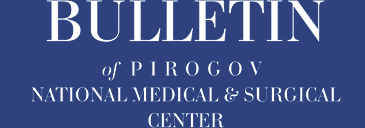Authors
Eliseev I.G.1, Lischuk A.N.1, Havandeev M.L.1, 2, Komendantova Yu.V.3, Gitelzon E.A.4, Faibushevich A.G.4
1 National Medical Research Center of High Medical Technologies – the Central Military Clinical Hospital of A.A. Vishnevsky, Krasnogorsk
2 Institute of Emergency and Reconstructive Surgery named after. V.K. Gusak, Donetsk
3 Russian State Social University, Moscow
4 RUDN University, Moscow
Abstract
Aims: to compare the efficacy and safety of mitral valve (MV) prosthesis using different surgical accesses (median sternotomy and lateral thoracotomy) in overweight patients; to evaluate the influence of the choice of access on complications, quality of life, survival and cardiac function, as well as to determine the risk factors for complications in combined surgical treatment of coronary heart disease and MV prosthesis.
Methods: Patient groups were formed depending on the type of surgical access: 50 patients underwent MV prosthesis through median sternotomy, and 80 patients underwent MV prosthesis through lateral thoracotomy. The study design was a retrospective cohort study. Surgical interventions were performed between 2015 and 2023. 130 overweight patients (BMI >30 kg/m2) with MV lesions were included in the analysis. Quality of life before and after surgery was assessed using the standard SF-36 questionnaire. Operative risk was assessed using Euroscore II scale, comorbid background was evaluated using Charlson comorbidity index. Statistical methods were used to analyze quantitative features: Student's t-test, Mann-Whitney test, and mixed general linear models.
Results: The use of lateral thoracotomy, in comparison with median thoracotomy, contributed to a more pronounced reduction in pain intensity and improved quality of life in most of the parameters assessed by the SF-36 questionnaire, including physical, lifestyle, social and emotional functioning, as well as physical pain, general health and vitality.
Conclusion: According to the results of the study, MV prosthesis using lateral sternotomy can be considered as a preferable method in overweight patients, as it is characterized by shorter duration of surgery, artificial circulation, artificial ventilation, and duration of hospitalization. Both types of access provide pronounced improvement of hemodynamic parameters and reduction of the functional class of chronic heart failure according to NYHA without statistically significant differences between the groups. However, when combined surgical treatment of ischemic heart disease is necessary, the choice of access should be based on the assessment of the risk of progression of the underlying chronic kidney disease.
Keywords: mitral valve, prosthesis, sternotomy, minithoracotomy, obstructive pulmonary disease, ischemic heart disease.
References
1. Bokeria LA, Samorodskaya IV, Bolotova EV, Urmanbetov KS. Organizational issues of cardiac surgical care for elderly patients with heart valve defects. Vestnik KRSU. 2012; 12(9): 24. (In Russ.)
2. Urmanbetov KS, Asanaliev MI, Javed BhA, Zhumabaev SA, Kalieva RS. History of the development of surgical treatment of mitral heart defect (literature review). Bulletin of the Kyrgyz State Medical Academy named after I.K. Akhunbaev. 2022; 3: 10-17. (In Russ.) doi: 10.54890/1694-6405_2022_3_10.
3. Komarov RN, Ognev OO, Ismailbaev AM, Cherniavskii SV, Dzyundzya AN, Lenkovets MV. State-of-the-art surgical approaches in minimally invasive aortic valve surgery. Pathology of Circulation and Cardiac Surgery. 2022; 26(3): 31-40. (In Russ.) doi: 10.21688/1681-3472-2022-3-31-40.
4. Abrolov KhK, Mamatov MA, Ziyaev ShA. Surgical correction of anomalous pulmonary vein drainage from right anterolateral thoracotomy. Re-health journal. 2022; 4(16): 26-30. (In Russ.)
5. Shevchenko YuL. Thirty-five years long-term result of mitral and aortic heart valve replacement with domestic ball prostheses. Grudnaya i Serdechno-Sosudistaya Khirurgiya. 2021; 63(1): 73-80. (In Russ.) doi: 10.24022/0236-2791-2021-63-1-73-80.
6. Shneider VE, Sokolova VV, Medvedev SD, Komarova LN. The effect of hyperglycemia on the development of postoperative complications in cardiosurgical patients. Medical Science and Education of the Urals. 2018; 19(3): 46-49. (In Russ.)
7. Dell’Amore A, Congiu S, Campisi A, Mazzarra S, Zanoni S, Giunta D. Sternal reconstruction after post-sternotomy dehiscence and mediastinitis. Indian J Thorac Cardiovasc Surg. 2020; 36: 388-396. doi: 10.1007/s12055-019-00880-5.
8. Pinto DCG, Bahia NAFC, Gonçalves FL, Gomes IC, et al. Factors Associated with Post-Sternotomy Mediastinitis. Case-Control Study. Int. J. Cardiovasc. Sci. 2018; 31(2): 163-172. doi: 10.5935/2359-4802.20180004.
9. Khaladj N, Shrestha M, Peterss S, et al. Isolated surgical aortic valve replacement after previous coronary artery bypass grafting with patent grafts: is this old-fashioned technique obsolete? European Journal of Cardio-Thoracic Surgery. 2009; 35(2): 260-264. doi: 10.1016/j.ejcts.2008.09.051.
10. Patel NC, Hemli JM, Seetharam K, Graver LM, et al. Reoperative mitral valve surgery via sternotomy or right thoracotomy: A propensity-matched analysis. J Card Surg. 2019; 34: 976-982. doi: 10.1111/jocs.14170.
11. Mkalaluh S, Szczechowicz M, Dib B, et al. Early and long-term results of minimally invasive mitral valve surgery through a right mini-thoracotomy approach: a retrospective propensity-score matched analysis. PeerJ. 2018; 6: e4810. doi: 10.7717/peerj.4810.
12. Pope NH, Ailawadi G. Mitral valve surgery: right thoracotomy approach //Diagnosis and treatment of mitral valve disease: a multidisciplinary approach. Philadelphia: Elsevier. 2022: 186-195.
13. Umakanthan R, Petracek MR, Leacche M, et al. Minimally invasive right lateral thoracotomy without aortic cross-clamping: an attractive alternative to repeat sternotomy for reoperative mitral valve surgery. The Journal of heart valve disease. 2010; 19(2): 236-243.
14. Chernov II, Makeev SА, Kozmin DYu, Tarasov DG. Multivalve heart surgery through a mini-access. Clinical and Experimental Surgery. 2018; 6(1): 21-26. (In Russ.)
15. Modi P, Hassan A, Chitwood JrWR. Minimally invasive mitral valve surgery: a systematic review and meta-analysis. European Journal of Cardio-Thoracic Surgery. 2008; 34(5): 943-952. doi: 10.1016/j.ejcts.2008.07.057.
16. Kofidis T. (Ed.). Minimally Invasive Cardiac Surgery: A Practical Guide (1st ed.). CRC Press. 2020. doi: 10.1201/9780429188725.
17. Karsan RB, Allen R, Powell A, Beattie GW. Minimally-invasive cardiac surgery: a bibliometric analysis of impact and force to identify key and facilitating advanced training. J Cardiothorac Surg. 2022; 7: 236. doi: 10.1186/s13019-022-01988-3.
18. Carpentier A, Loulmet D, Carpentier A, et al. Chirurgie à coeur ouvert par vidéo-chirurgie et mini-thoracotomie. Premier cas (valvuloplastie mitrale) opéré avec succès. Comptes rendus de l'Academie des sciences. Serie III, Sciences de la vie. 1996; 319(3): 219-223.
19. Skopin II, Narsiya BE, Vavilov AV, Latyshev MS. Minor invasive mitral valve surgery. Grudnaya i Serdechno-Sosudistaya Khirurgiya. 2017; 59(4): 238-245. (In Russ.)


